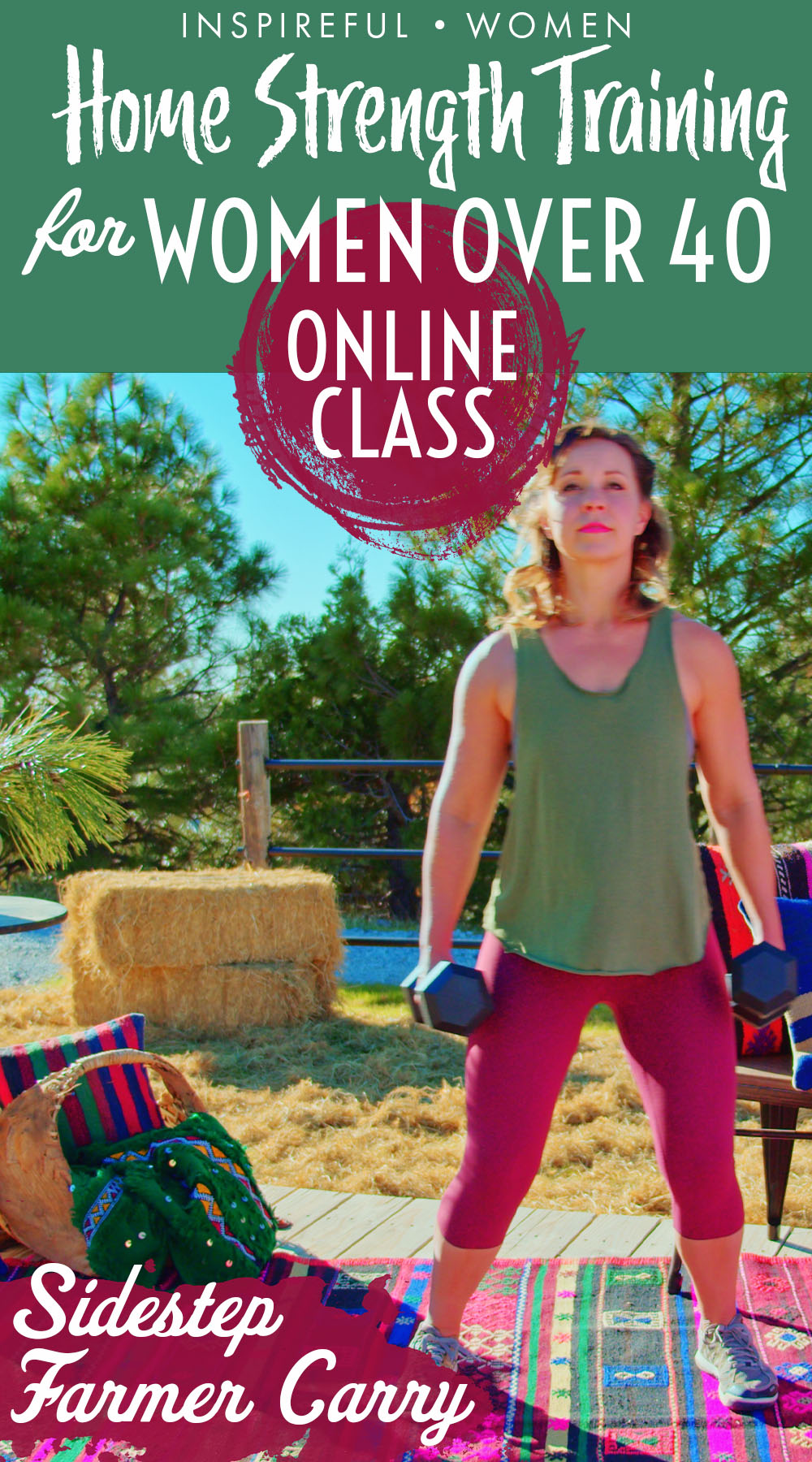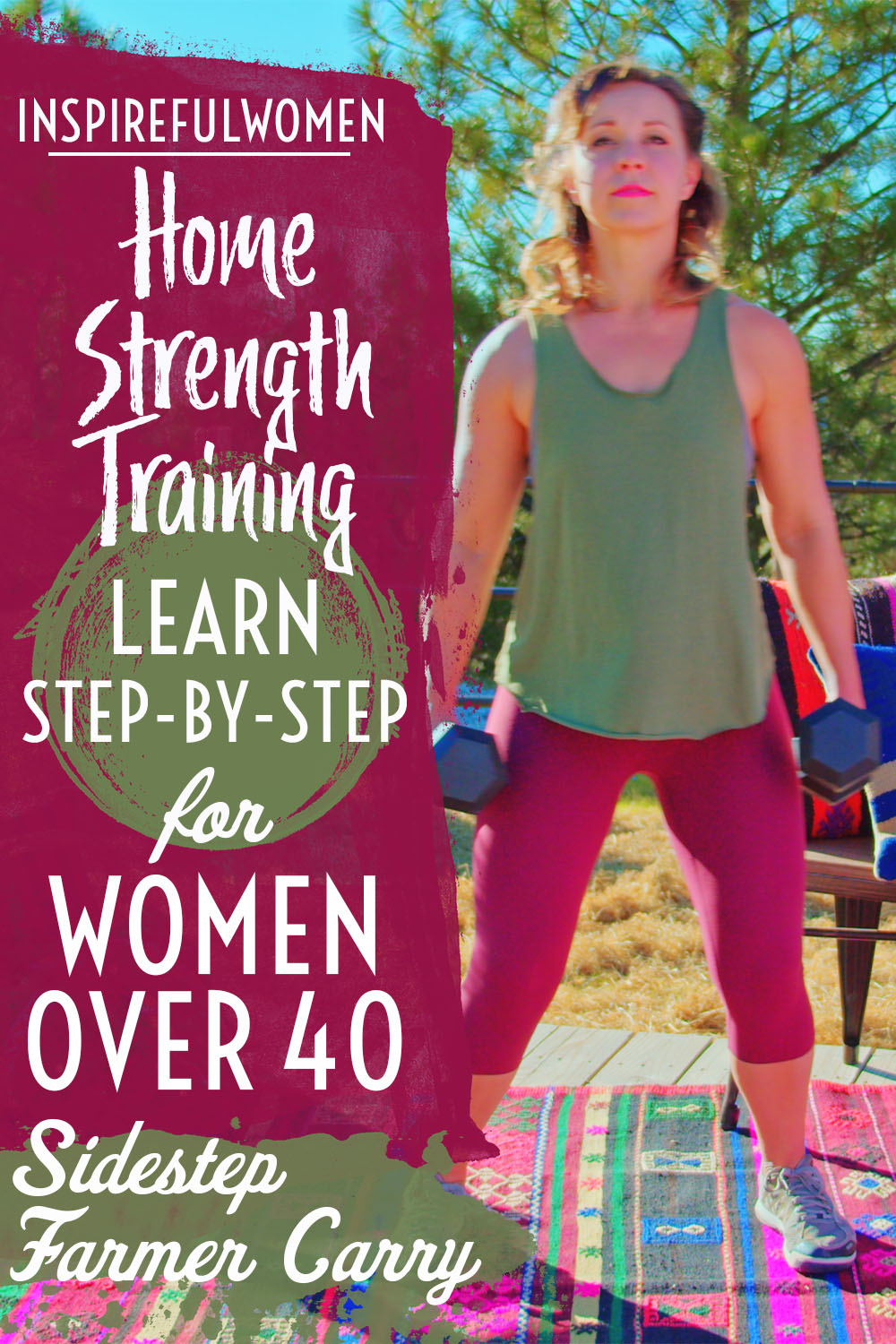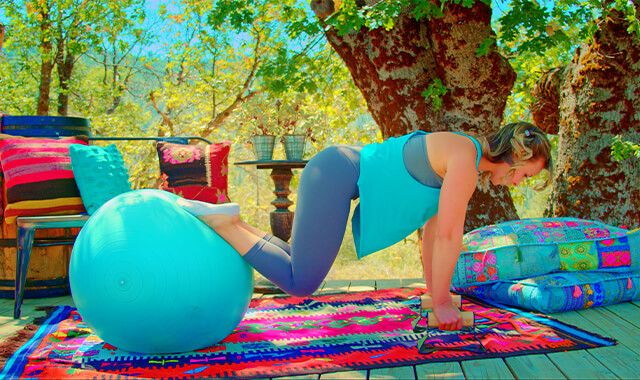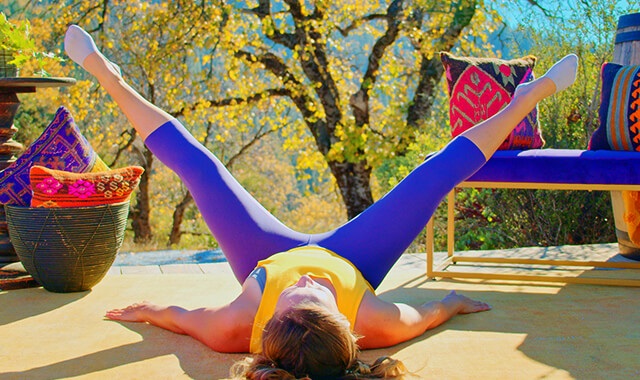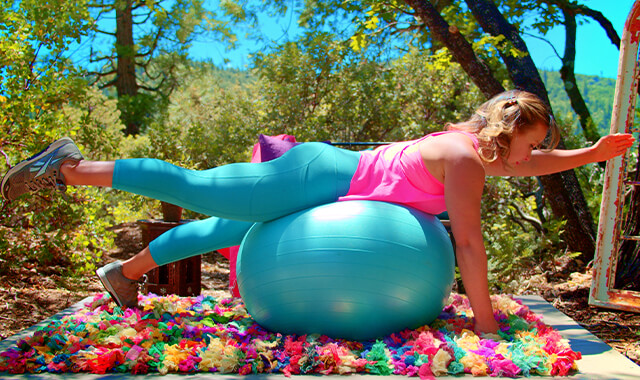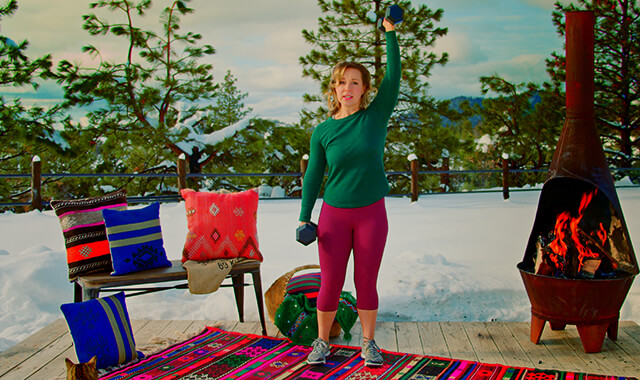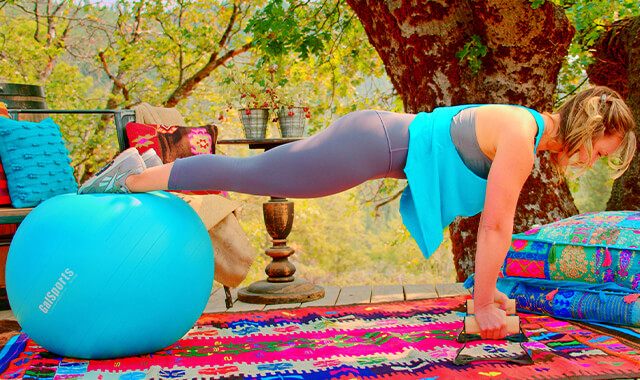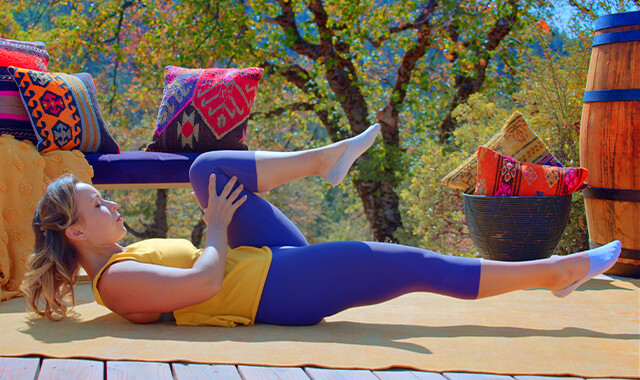Sidestep Farmer Carry - core exercise
How to Do the Sidestep Dumbbell Farmer Walk - Grip Strength Exercise | In-Depth Guide [VISUAL LEARNERS] Beginner
Proper Form & Common Mistakes | Home Resistance Training
WHAT DO YOU WANT TO SEE?
QUICK DEMO
QUICK DEMO
MUSCLES THIS WORKS
MUSCLES
MAIN MUSCLES WORKED IN the Sidestep Farmer Carry
ALL CORE MUSCLES
OTHER MUSCLES WORKED:
- Most muscles of the upper and lower body
STARTING POINTERS
Starting Pointers
WHAT WE'RE DOING TODAY
Other names for this exercise: Lateral Farmer Carry
ALL WE'RE DOING:
Side-stepping while holding heavy dumbbells
This farmer carry variation can be done by stepping to the side instead of forward walking. This core strengthening exercise will work the muscles on the inside and outside of the thighs more. Another benefit of this easy beginner exercise is improved grip strength and toner forearms.
This is a nice way to add movement in a different direction (a different plane of motion), not the same way we move in daily walking. It seems like there is a lot more focus on exercises targeting the muscles on the front and back of the legs. This is a good way to add another exercise for the inner and outer leg muscles. This not only gets the inner and outer thigh muscles but also will work the muscles that support the inside and outside of the lower leg, ankle, and feet. These muscles are really important for ankle stability, prevention of ankle sprains, balance, and recovering from a slip or trip to prevent a fall. They also play a big role in the health of the feet, preventing pronation or supination.
As with the other versions of the Farmer's Walk, the focus is on holding your spine neutral and very still. You can imagine balancing a book on your head. This can be a little more challenging when sidestepping - the tendency is to lean the trunk instead of lifting the leg out to the side. You should see a crease on the outside of the hip at the top of the leg when you step out to the side.
HOW TO DO THE EXERCISE
LOOKS
HOW Sidestep Farmer Carries SHAPE OUR BODY
Toned midsection, arms, forearms, thighs, and calves. Good posture. Strong and confident movement.
PROPER FORM
PROPER FORM: Sidestep Farmer Carries
EQUIPMENT, SETS & REPS
EQUIPMENT
Shoes if needed to help to absorb the impact
SUGGESTED STARTING WEIGHT FOR WOMEN:
2 dumbbells or kettlebells:10-30 lbs (in each hand)
SETS & REPS:
25 - 30 steps to the side and 25 -30 steps back x 3-5 times; or 25-30 seconds total x 3-5 times
PACE:
Focus on form, rest when needed
BODY POSITION
BODY POSITION FOR THE Sidestep Farmer Carries
FEET: Feet in a normal stance, for your normal walking. Toes forward.
BODY STANCE: Standing with a neutral spine (includes neck), sternum lifting, and your shoulder blades in and down. Space between your earlobe and the top of your shoulder.
KNEES: Both knees will have a slight bend throughout the exercise.
HAND/GRIP: Grip the weights like you would heavy grocery bags by the handles, fingers and thumbs curled around the handle securely.
ARMS: Arms holding weights at sides - you will need to hold the weights far enough from your sides that they don’t interfere with your leg stepping out to the side. Your shoulders should be stacked over the hips. Your elbows should have a bend to decrease the strain on your ligaments and put your muscles in a position in which they are able to work to stabilize your elbow joint.
HOW TO DO
HOW TO DO the Sidestep Farmer's walk
CUE: Your upper body should not move, concentrate on not leaning. Keep your toes pointed forwards, and try to lift your foot straight up and set it down flat.
With slightly bent, soft knees, take a step out to the side without leaning your body.
Place your stepping foot down flat. You can toe in a bit if you like- will help work the glute medius.
Bring your trailing leg in, and set it right beside your stepping leg (step together basically).
Really try to land flat on your foot as you step, rather than touching down toes first then heels, or lifting off heel first, then toes - doing the latter will reduce most of the muscle activation as the movement is coming mostly from the ankle joint bending rather than muscles while landing flat on your foot will get the most benefit for the hip muscles.
Continue to side step for the desired number of steps.
Without turning around, step back to the starting position.
Repeat for the desired number of sets, or walk for a set period of time.
HOW TO SAFELY GET OUT OF THE EXERCISE
Squat down and place the weights on the floor.
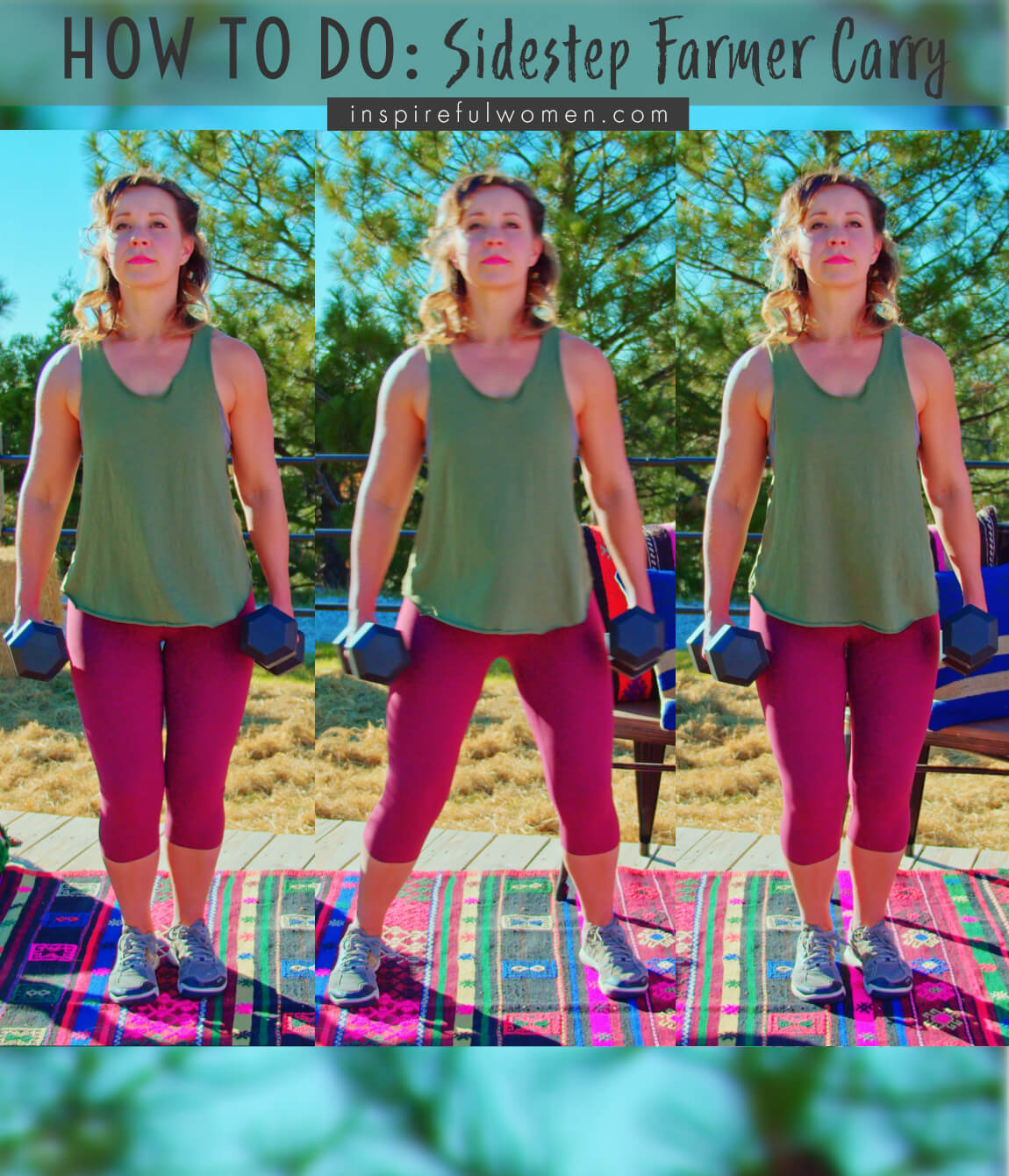
COMMON MISTAKES
COMMON MISTAKES
WHAT TO AVOID WITH THE Sidestep Farmer Carry
KEY TIP:
Guess what? Good news! Many avoids are the same for most movements. Once you learn the basics, there's really only a few extra avoids for each individual movement.
1. Avoid Chest Caving In
AVOID: Letting the trunk collapse forward.
WHY NOT?
- This puts a lot of compression through the spine which can cause injury.
WHAT TO DO:
- Keep the sternum lifted, and your shoulders back, and activate your core muscles to prevent slouching forward.
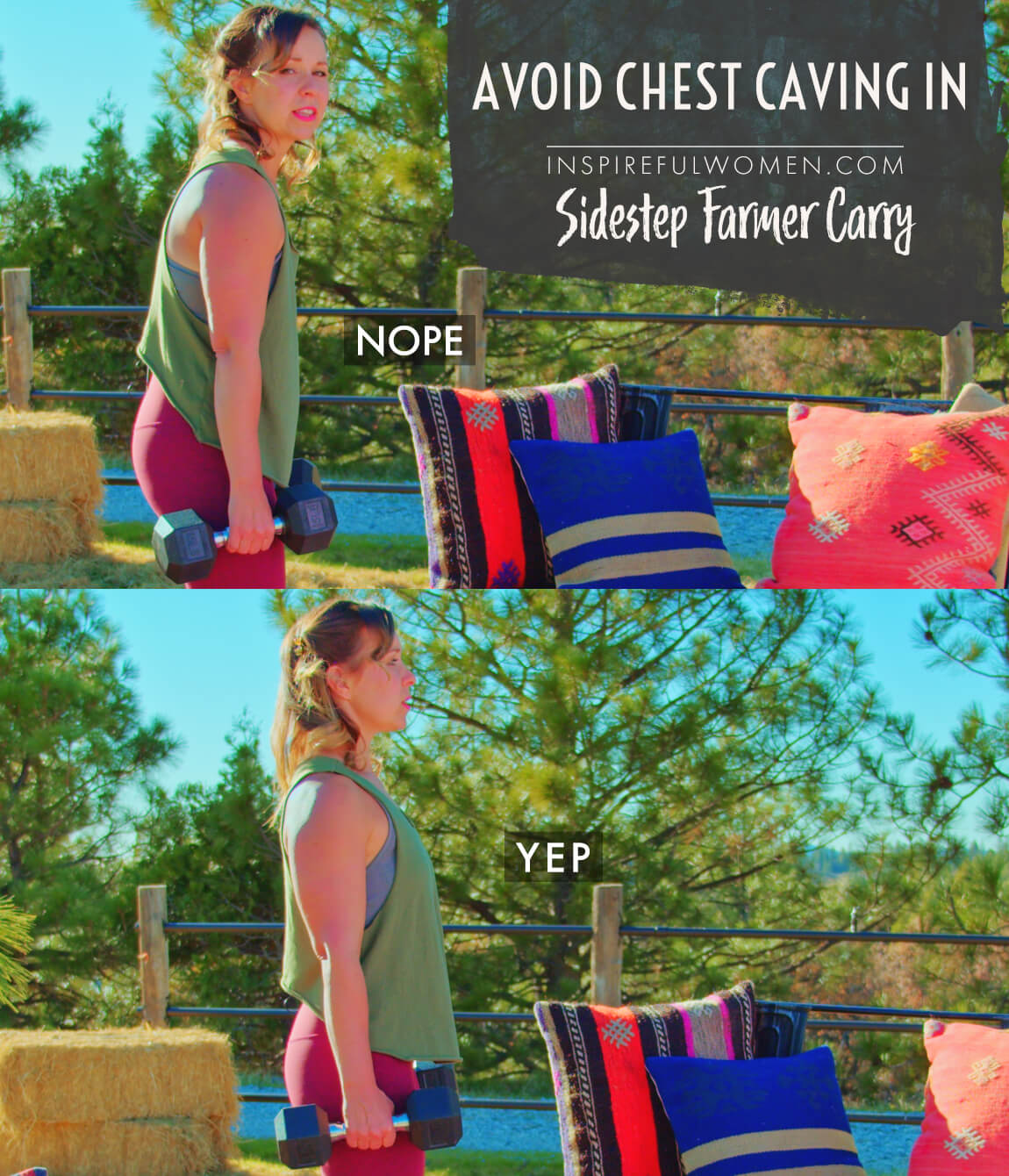
2. Avoid Steps Too Big
AVOID: Taking steps that are too big.
WHY NOT?
- This results in a lurching motion because you are shifting your weight along with the weight you are holding forward and backward.
- This is similar to being top-heavy and swaying your upper body back and forth.
- May cause injury to the low back trying to correct the center of mass and maintain good posture.
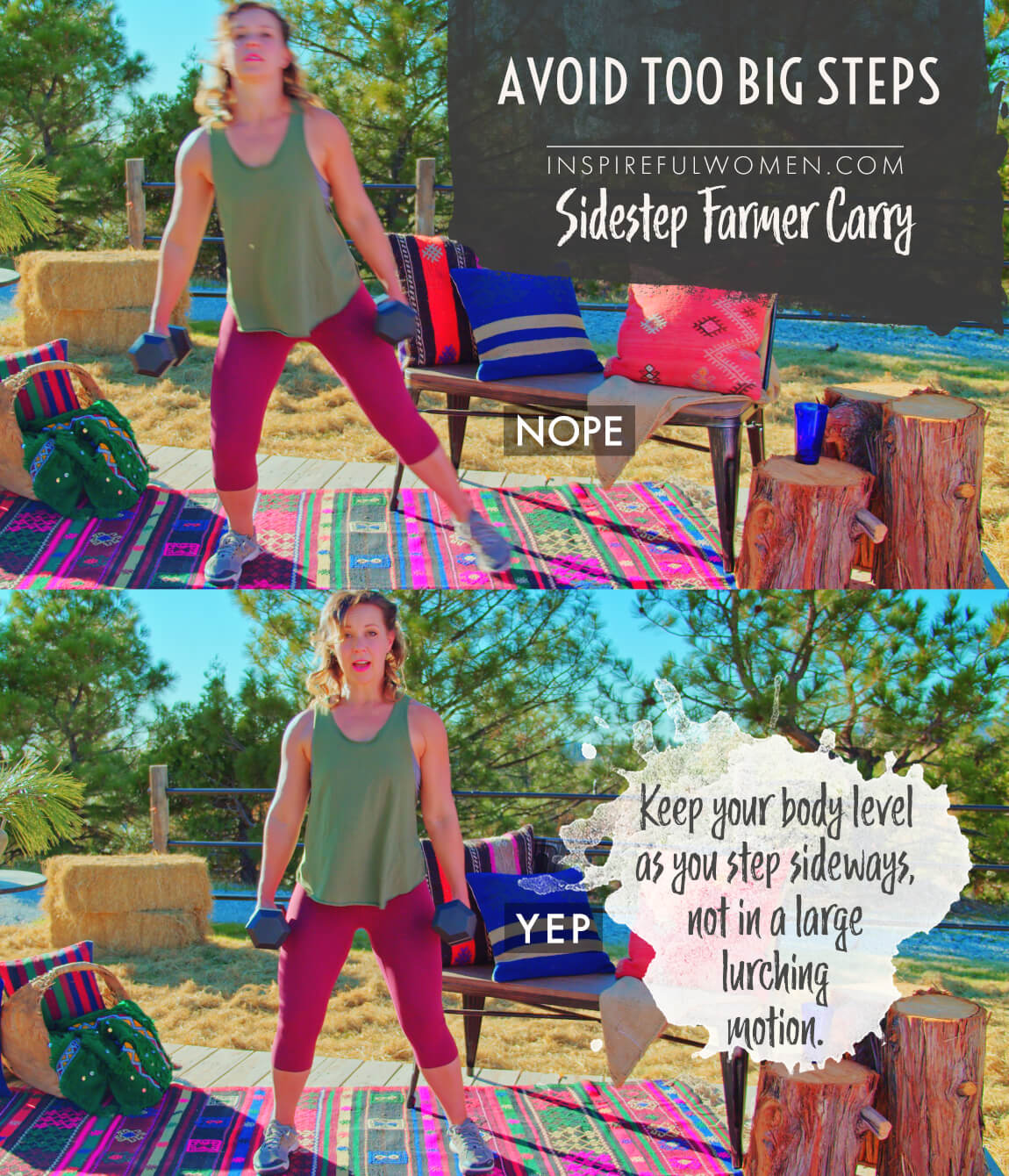
3. Avoid Shuffling/Sliding
AVOID: Shuffling the feet.
WHY NOT?
- This will decrease the effectiveness of the exercise.
- This is a core exercise, designed to work the muscles of the core as you lift one leg and then the other.
WHAT TO DO:
- Make sure that you are lifting your feet and taking small controlled steps while you are holding good posture.
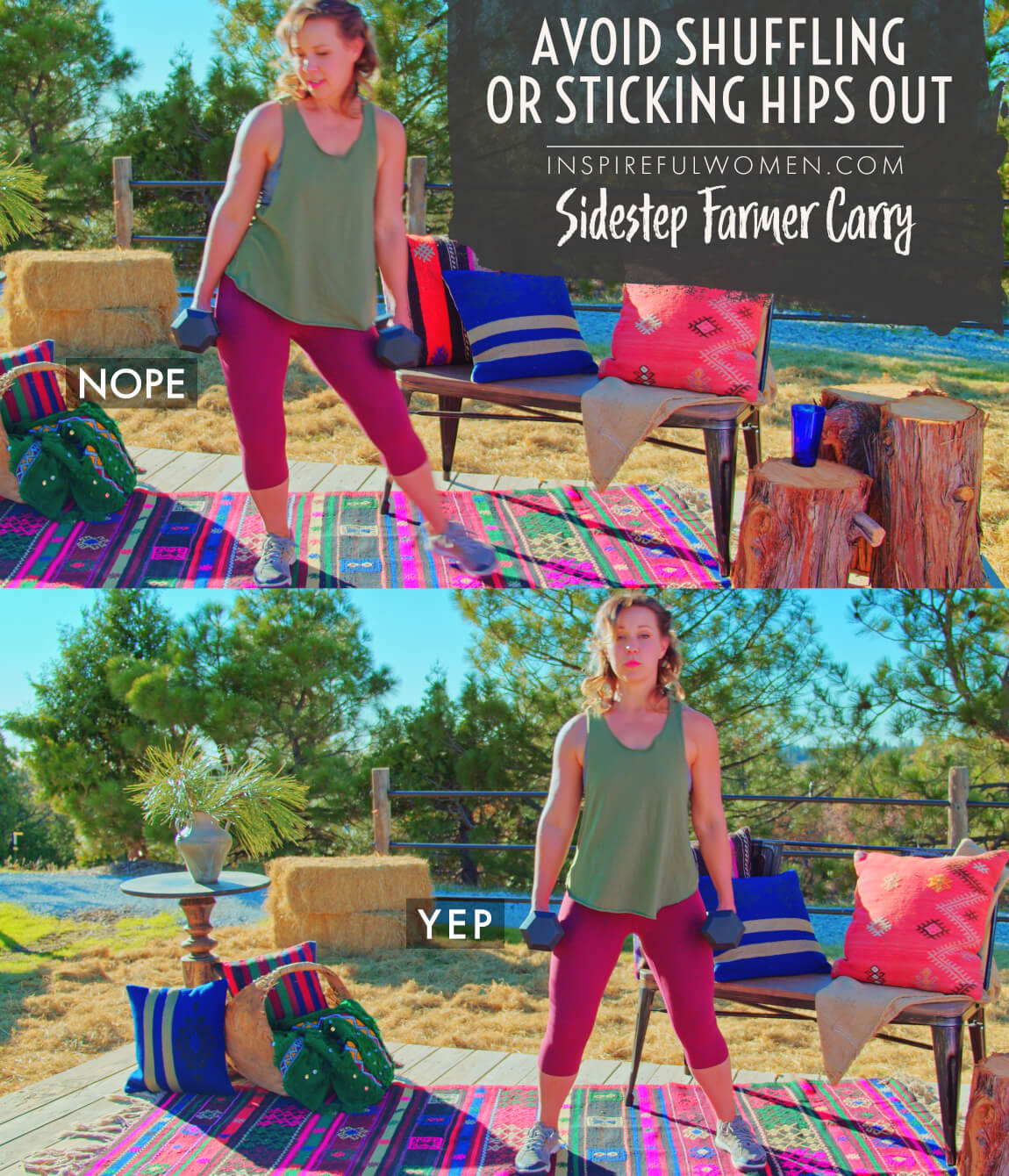
4. Avoid Knees Collapsing In
AVOID: Letting the knees collapse in (or bow out - but that is much less common).
WHY NOT?
- This is not the proper alignment of the legs.
- This can strain the ligaments (medial and lateral collateral) that support the sides of the knee.
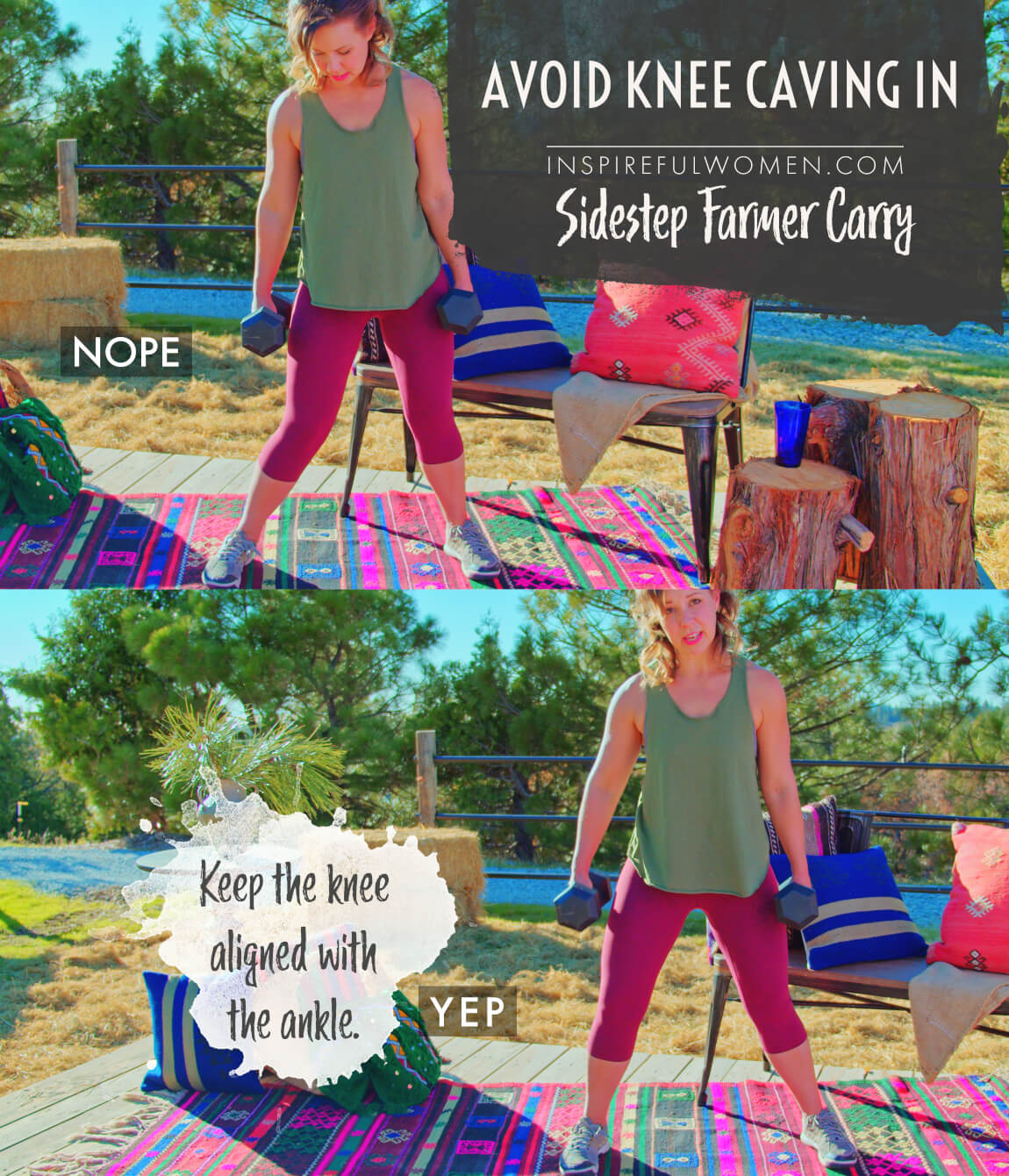
5. Avoid Foot Rolling In Out
AVOID: Letting the feet roll in (pronation) or out (supination).
WHY NOT?
- The arch of the foot is designed to move with each step to absorb the impact of the body’s weight as the foot makes contact with the floor.
- When you add more weight to the body, the muscles of the leg and foot have to absorb more shock.
- If the foot is not properly aligned, it can cause damage to the soft tissues or joints of the foot, or even the lower leg, knee, hip or back.

WHAT WE'RE DOING TODAY
WHAT & WHY
BENEFITS OF TRAINING core MUSCLEs
WHAT
The Farmer Carry is a total body exercise. This is a very straightforward exercise - you hold heavy weights in your hands while you walk. The goal IS to hold fairly heavy weights- this is not a 5 lb dumbbell exercise, even for us ladies. The added weight loads the spine in a healthy way, challenging all of the posture muscles, as well as improving our grip strength. The hands, arms, and shoulders have to work hard to hold the weight and the legs need to work to move the weighted body. The focus is on:
- Keeping your spine in good alignment (perfect posture)
- Lifting your feet as you walk, and
- Holding the arms still under the added load for approximately 30 seconds.
This may not seem like a long time but this is a very challenging exercise. There are many interesting versions to try, you can mix and match different variations to target many different muscle groups.
Ideas for heavier loading when you don’t have heavier dumbbells or kettlebells:
- Actual grocery bags with heavier items in them
- Laundry detergent jugs
- Milk jugs
- Full water bottles
- If any of these items are uncomfortable on your hands, you can wrap a small towel around the handle
WHY BOTHER DOING IT?
WHY
WHY DO WE EVEN CARE?
BENEFITS OF FARMER CARRIES:
- Core Strength
- Grip Strength
- Back Muscles
- Posture correction
BECAUSE CARRY HEAVY THINGS WE DO
The Farmer Carry is a very functional exercise. We have to be able to carry things, and we need to be able to do so with good posture and alignment to prevent injury. This exercise is good for increasing the strength and stability of all of the muscles needed to create a stable base for the arms and legs to work off of - making it a good foundation exercise for if you want to be able to safely push/pull/lift/carry more weight.
It does not matter how strong your arms are if the rest of the body cannot support the weight. This exercise helps to strengthen “the rest of the body”. The muscles that surround the shoulder, elbow, wrist joints, core, hips, and legs will have to work to stabilize the joints as they carry the heavy load.
IT'S ABOUT LEARNING TO KEEP STILL WHILE MOVING - NO MORE SLOPPY JOINT MOVEMENT
In the Farmer Carry, there is very little joint movement*, the focus is on holding the body pretty still. The only joint movement is in the hips, knees, ankles, and feet, but the range of movement is pretty small. *There are some variations that involve arm movement. Loading the body but limiting the movement at the joints is a good way to strengthen the muscles that stabilize the joints. Stabilizing joints means being able to prevent excessive movement at joints when holding or moving heavy things. If the muscles surrounding these joints are not trained to do this, excessive movement or unhealthy movement in the joint can occur in a way it’s not designed to, causing damage over time or injury to the cartilage & ligaments. The joint movement is sloppy.
The muscles are worked under a moderate to heavy load for a longer duration of time (longer than most weight-lifting exercises), without much active movement of the joints. This trains the muscles for endurance - working for a long time, as opposed to short bursts of activity. The shoulder and elbow joints are holding a heavy weight that pulls down on the arm - the muscles of the shoulder region and arm must work together and stabilize (compress - to prevent dislocation) the joints.
GRIP STRENGTH
I don’t know about you, but I often find that I have the strength for something heavy when it comes to most other parts of my body EXCEPT my hands- my grip. My legs are fine, my core is fine, and my shoulders/upper arms are fine- but it’s my grip & my hands that are giving out.
This is also a very good exercise for training grip strength, not only gripping to hold but holding for a longer period of time - like when you have to lift and push a loaded wheelbarrow for a long distance. Poor grip strength can interfere with the ability to live independently. The elderly have difficulty with gripping for simple activities like turning doorknobs, opening jars, using a can opener, opening medicine bottles, picking small items up, using hammers, and turning on faucets. As young as 40 years of age, grip strength can begin to decline. In older adults (around 60) grip strength has been used as a way of measuring general body strength and overall muscle mass. Research has even associated decreasing grip strength with declining cognition, mobility, functional status, and mortality.
CALF STRENGTH
Other benefits of the Farmer Carry include improving calf strength which puts the spring in your step. The calf muscles are responsible for the push-off while you walk. This is something that also decreases with age, leading to a slower gait, and shorter stride length. Also improves static (standing still) and dynamic (walking, stair climbing, running) balance.
This is great because there are not a lot of home exercises that specifically target the calves well, where we point our toes to some degree, outside of the various calf raises we have, which are really just variations of 1 exercise, the calf raise. Many other exercises like squats will utilize the calves to some degree, but since the foot remains flat on the floor the whole time, we’re not getting a really good full range of motion contraction for the calf in a movement like that.
GOOD FOR BONE DENSITY
This exercise is a good weight-bearing exercise - the increased load will increase the load put through the bones of the spine, pelvis, and legs. This type of exercise builds bone density, so good for the prevention and or treatment of osteopenia and osteoporosis.
EVERYDAY LIFE
EVERYDAY LIFE &
MUSCLE FUNCTION
HOW WE USE OUR core MUSCLES IN EVERYDAY LIFE
CORE MUSCLES:
1. HOLD YOUR TORSO UPRIGHT
The main job of the core muscles is to hold you stable any time that you are upright and when you move. The core muscles work together in coordination all day long. The amount of muscle activity increases with the intensity of the activity. The core muscles are more active during:
- Carrying
- Kids
- Grocery bags
- Water softener salt
- Dog Food
- Cement
- Suitcases
2. THE CORE MUSCLES TRANSFER FORCE FROM THE LEGS TO THE ARMS DURING:
- Lifting
- Kids
- Boxes
- Groceries
- Pushing
- Wheelbarrow
- Heavy grocery cart
- Stroller
- Lawnmower
- Vacuum
- Pulling
- Wagon
- Garden hose
FARMER CARRIES TRAIN HAND/FOREARM MUSCLES IN THIS WAY:
3. GRIP STRENGTH
- Opening jars
- Using a can opener
- Buckling seat belts
- Turning a doorknob
- Carrying items with handles
- Baby car seat
- Suitcases
SCIENCY STUFF
SCIENCY STUFF
SPIFFILICIOUS FACTS ABOUT MUSCLES & MOVES
The shoulder joint (glenohumeral joint - between the shoulder blade and the upper arm bone) is the least stable joint in the body. The only bony attachment it has to the spine is at the joint between the collarbone (clavicle) and the top of the breastbone (sternum). The arm is held in the socket of the shoulder blade by many ligaments and a small cup-shaped cartilage (the labrum) that acts somewhat like a suction cup. When the arm is just hanging by the side of the body, the muscles are not active. When moving the arm or lifting an object, the muscles (rotator cuff and others) act to hold the joint together under the added load. If the load is too heavy it will overpower the muscles that are supporting the joint. This can result in damage to the muscle, ligaments, cartilage, or bones. In addition to this, the shoulder blade is essentially floating in a sea of muscles. The only attachment to the spine is through the collarbone to the sternum. This makes it extremely mobile. When you pick up an object, if the muscles that hold your shoulder blade still are too weak to stabilize against the load you are lifting then instead of the arm lifting up the object, the shoulder blade will be pulled down and forward (into protraction and downward rotation). In order to have normal mechanics (the muscles working to keep the shoulder joint together) when lifting an object, the shoulder blade must be stable so that the arm moves as opposed to the shoulder blade moving. An analogy would be a swing hanging from a branch. If the branch and the trunk are stable and you tie a swing to the branch then you can sit on it. If the area where the branch attaches to the tree is weak and you sit in the swing, then the branch may break off of the strong trunk. If the branch is strongly attached to the trunk but the trunk is weak, then the trunk may bend and break. The heavier the person on the swing, the stronger the trunk needs to be in order to be able to support the branch, especially if you add weight to the branch. So it does no good to strengthen an arm if you do not strengthen the supporting structure, in fact, it can do a lot of damage. Furthermore, the supporting structures (branches and the trunk) usually don’t break right away. The structure is weakened over time until it fails. This is true for overloading any object, over time the supporting structure will suffer tiny bits of damage (cracks), bend, and eventually break under the load.
ALLLL MUSCLES & WHEN
ALL MUSCLES WORKING & WHEN DURING THE Sidestep dUMBBELL Farmer Carry
The muscles of the trunk, shoulders, arms, wrists, and hands will work throughout the exercise. The muscles of the trunk work as shock absorbers for the spinal column under the increased compression due to the increased load (holding weights in arms). The trunk muscles also work to hold the body in an upright position during walking.
The muscles of the shoulders, arms, and forearms work to stabilize the shoulder, elbow, and wrist against the traction (downward pull of gravity pulling the joints apart) of the joints. The muscles of the forearm and hand work to grip the weight.
The side stepping starts with the muscles on the outside - gluteus medius, minimis, and peroneals, of the stepping leg working concentrically to lift the leg out to the side. All of the muscles of the stepping leg will contract to stabilize as the trailing leg is brought over to meet it (the adductors of the trailing leg act concentrically to move the leg in, but the effort is minimal, only the weight of the leg moving horizontally).
In sidestepping the tendency is to lean the upper body when you step out. The quadratus lumborum and obliques will be more active (than in the standard Farmer Carry - forward walking) to hold the spine neutral.
PIN IT FOR LATER!
